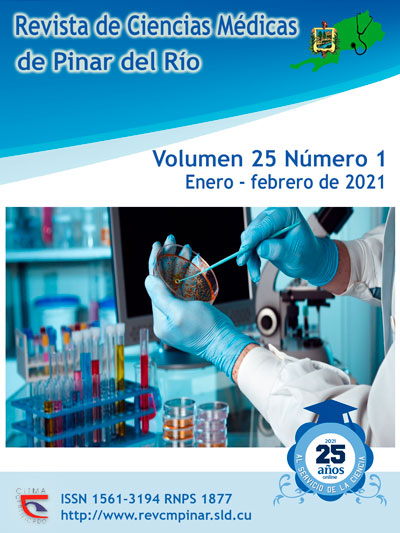Venous aneurysm as a complication of an internal arteriovenous fistula for hemodialysis: a case report
Keywords:
ARTERIOVENOUS FISTULA/complications, VENOUS ANEURYSM, TOTAL ANEURYSMECTOMY.Abstract
Introduction: two frequent complications that present a poor function of the internal arteriovenous fistulas are thrombosis and stenosis. Other complications such as aneurysms, although less frequent, are not unimportant; they require a timely intervention to avoid the failure of such approach.
Case report: a patient who is intervened due to a venous aneurysm of internal arteriovenous fistula and treated with total aneurysmectomy. Vascular approach was not preserved; a temporary catheter was placed in the right internal jugular vein while waiting for a new vascular approach to be made, and there were no complications.
Conclusions: the treatment is at the discretion of the vascular surgeon; due to the clinical elements found, as well as the degenerative changes as a result of the local inflammatory process. The aneurysms of the arteriovenous fistulas constitute a complication of low frequency, but they are not exempt from rupture. It is observed both in autologous arteriovenous fistulas and in autologous and heterologous grafts. The danger of spontaneous rupture at a marked skin-toning site as a result of repeated punctures is an indication for prompt surgical procedure. The treatment is at the discretion of the vascular surgeon and it is important the multidisciplinary team cares for the fistula during its projected lifespan.
Downloads
References
1. Brescia MJ, CiminoJE. Chronic haemodíalysis using venipuncture and surgically created arteriovenous fistula. N Engl J Med [Internet]. 1966 [citado 12/07/2019]; 275(20):1089-92. Disponible en: https://pubmed.ncbi.nlm.nih.gov/5923023/
2. Rivera JM. Accesos vasculares para hemodiálisis: La fistula arterio-venosa como primera opción [Tesis]. Murcia: Universidad Católica de Murcia, Facultad de Enfermería; 2014 [citado 12/07/2019]. Disponible en: http://repositorio.ucam.edu/bitstream/handle/10952/1280/Rivera%20Caravaca%2c%20Jos%c3%a9%20Miguel.pdf?sequence=1&isAllowed=y
3. González Pinto A, Zumel MF, Polo MG, Tarnames S. Complicaciones de las fístulas arterioveno internas para la hemodiálisis. SEDYT [Internet]. 2013 [citado 12/07/2019]; 2(3): 89-94. Disponible en: http://www.sedyt.org/revistas/1980_2_3/1980_2_3_89_94.pdf
4. Franco Pérez N, Rodríguez Hung S, Telemaque H. Comportamiento de las fístulas arteriovenosas para hemodiálisis en pacientes con insuficiencia renal crónica. Rev Cubana Ang Cir Vas [Internet]. 2015 [citado 12/07/2019]; 16(1): 3-8. Disponible en: http://scielo.sld.cu/pdf/ang/v16n1/ang02115.pdf
5. Díaz F, Polo JR, Lorenzo V. Accesos vasculares subcutáneos. Manual de nefrología. 2da ed [Internet]. Madrid: Harcourt, SA.; 2002 [citado 12/07/2019]. Disponible en: http://www.sciencedirect.com/science/article/pii/S0211699517302171
6. Sosa OR. Fístulas arterio-venosas trombosadas para hemodiálisis y su tratamiento. Rev Cubana Ang [Internet]. 2017 [citado 22/04/2019]; 18(2): 192-201. Disponible en: http://scielo.sld.cu/scielo.php?script=sci_arttext&pid=S1682-00372017000200006
7. González De Leo S, Rodríguez Ramírez N, RizoGarcía Y, Romero García I. Aneurismas venosos gigantes de fístulas arteriovenosas. RevMexAngiol [Internet]. Jul-Sep2016 [citado 22/04/2019]; 44(3): 106-111. Disponible en: https://www.medigraphic.com/pdfs/revmexang/an-2016/an163d.pdf
8. Crehuet Rodríguez I, Bernárdez Lemus MA, Toribio Manrique B, Sánchez Arribas Mdel M, Villa Ruíz R, Ramírez Crehuet M. Rescate de un acceso vascular para hemodiálisis: a propósito de un caso. EnfermNefrol [Internet]. Dic 2015 [citado 29Abr2019]; 18(4): 315-319. Disponible en: http://scielo.isciii.es/scielo.php?script=sci_arttext&pid=S2254-28842015000400010&lng=es
9. Georgiadis GS, Lazarides MK, Panagoutsos SA, Kantartzi KM, Lambidis CD, Staramos DN, et al. Surgical revision of complicated false and true vascular access-related aneurysms. J VascSurg [Internet]. 2008 [cited 22/04/2019]; 47(6): 1284-1291. Available from: http://www.ncbi.nlm.nih.gov/pubmed/18514844
10. Romero Espinosa L, Serrano Lozano JA, Sánchez Nicolat NE, Loera Barragán A, Lozano Corona R. Evaluación por ultrasonido de complicaciones en fístulas arteriovenosas en pacientes con insuficiencia renal crónica que acuden al Servicio de Hemodiálisis del Hospital Regional “Lic. Adolfo López Mateos”. RevMexAngiol [Internet]. 2017 [citado 22/04/2019]; 45(2): 50-56. Disponible en: https://www.medigraphic.com/cgi-bin/new/resumen.cgi?IDARTICULO=75405
11. Franco Pérez N, Valdés Pérez C, Savigne Gutiérrez WO, Reynaldo Concepción D. Posibles causas de aneurisma y pseudoaneurisma de la fístula arteriovenosa en pacientes con insuficiencia renal. Rev Cubana AngCirVas [Internet]. 2015 [citado 29/09/2019]; 16(2): 205-215. Disponible en: http://scielo.sld.cu/scielo.php?script=sci_arttext&pid=S1682-00372015000200008
12. Delgado Ramírez A, Ruiz García E, Latorre López L, Crespo Montero R. Factores que influyen en la supervivencia de la fístula arteriovenosa interna y su relación con la técnica de punción. EnfermNefrol [Internet]. Jul-Sep2016 [citado 22/04/2019]; 19(3): 215-230. Disponible en: http://scielo.isciii.es/scielo.php?script=sci_arttext&pid=S2254-28842016000300004
13. Rosales Jiménez JM, Guzmán Rico SM, Fernández Ramírez Lizárraga P. Aneurisma cubital proximal de origen ateroescleroso: reporte del caso y revisión de la literatura. RevMexicanaAngiol [Internet]. 2009 [citado 22/04/2019]; 37(2): 62-65. Disponible en: https://www.yumpu.com/es/document/view/12119209/aneurisma-cubitalpd
Downloads
Published
How to Cite
Issue
Section
License
Authors who have publications with this journal agree to the following terms: Authors will retain their copyrights and grant the journal the right of first publication of their work, which will be publication of their work, which will be simultaneously subject to the Creative Commons Attribution License (CC-BY-NC 4.0) that allows third parties to share the work as long as its author and first publication in this journal are indicated.
Authors may adopt other non-exclusive license agreements for distribution of the published version of the work (e.g.: deposit it in an institutional telematic archive or publish it in a volume). Likewise, and according to the recommendations of the Medical Sciences Editorial (ECIMED), authors must declare in each article their contribution according to the CRediT taxonomy (contributor roles). This taxonomy includes 14 roles, which can be used to represent the tasks typically performed by contributors in scientific academic production. It should be consulted in monograph) whenever initial publication in this journal is indicated. Authors are allowed and encouraged to disseminate their work through the Internet (e.g., in institutional telematic archives or on their web page) before and during the submission process, which may produce interesting exchanges and increase citations of the published work. (See The effect of open access). https://casrai.org/credit/



